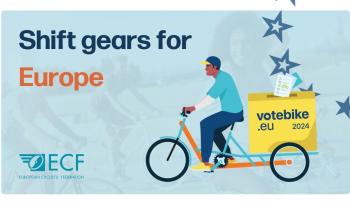
Does Cycling Data Help? The Simple Answer is Yes!
This invigorating session at Velo-city 2019 focused on the role of cycling data in informing policymakers and planners. It began with a presentation from ECF’s Fiscal and Economic Policy Officer, Holger Haubold, who explained the role data plays in informing European policy decisions from his experience. He was especially excited to see that many of the more recent EU legislations that have been passed (or are very close to completion) will include provisions that require the collection of data. The Road Infrastructure Safety Management Directive was highlighted as a particularly good example of what is possible, even if many further steps could still be taken.
Claire French, Executive Engineer from Dublin City Council, was next to speak describing Velo-City 2019 host city’s experience with Cycling Data. Claire presented very interesting statistics to demonstrate how detailed data about cyclists was used to plan available funds for improving cycling infrastructure in Dublin. She posed the interesting question however: Should investments go to where there are most cyclists currently? Or should the money go to where cycling has the most potential to grow? Her answer: Ideally both, but in reality, Dublin City Council does their best to weigh up the advantages and disadvantages of each individual project.
Rosa Félix, a researcher at the University of Lisbon spoke authoritatively about her city's experience in using pen and paper methods to gather cycling data, rather than relying on automatic counters. Surprisingly, she discovered that humans collected far more data about a piece of infrastructure than would be possible with a mechanized system. This data helped explain how the 10 fold rise in cycling in Lisbon between 2011 and 2019 happened; the impacts of a big expansion in cycling infrastructure in 2017; the impact of a bike-sharing scheme in 2018 and the recent arrival of e-scooters. Clearly doing data collection ‘the old fashioned way’ can sometimes pay real benefits!
Lastly, Marie Kastrup, the head of the City of Copenhagen’s bicycle program spoke about Copenhagen’s experience of data collection regarding cycling. As the city with some of the highest cycling modal share statistics in the world, and where infrastructure is some of the best in the world, she told us that good data collection is just as important. Among a large number of infrastructure projects built, the project of the Noorebrogade bridge stood out. Whilst controversial at the time, the project significantly reduced the number of lanes available to cars on a major inner-city bridge, which was justified using the colleced data. When it was discovered that the number of people crossing the bridge, after the project was over, had jumped by almost 20% between 2008 and 2016, the projects wisdom became hard to ignore.
Network/Project Involved:
Contact the author
Recent news!
Upcoming events
Contact Us
Avenue des Arts, 7-8
Postal address: Rue de la Charité, 22
1210 Brussels, Belgium









